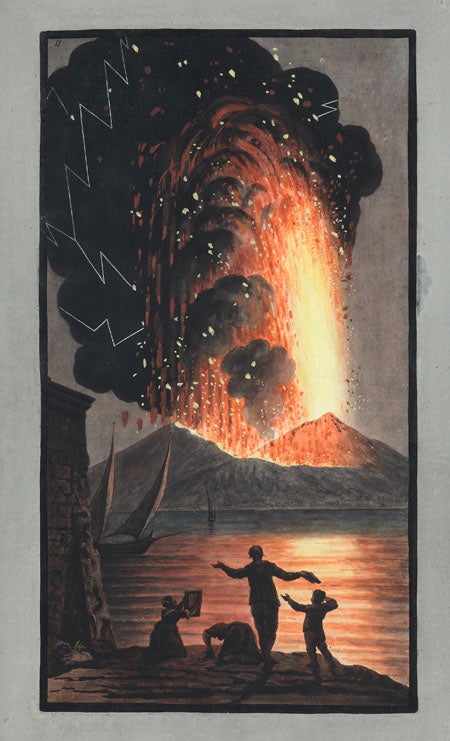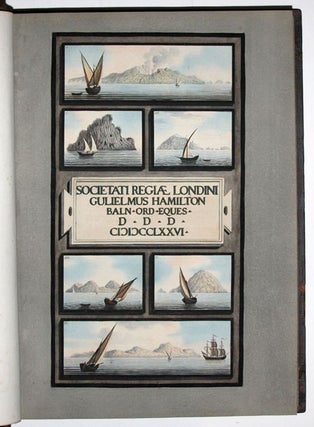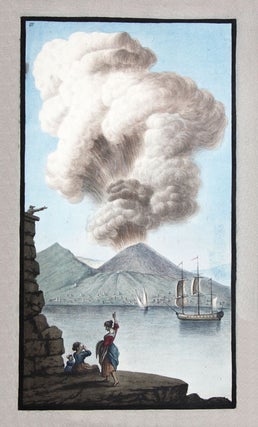Campi Phlegraei: Observations on the Volcanoes of the Two Sicilies, as They Have Been Communicated to the Royal Society of London.
Folio, 2 vol. in 1.
I (1776): (3) ff. comprising title, colored frontispiece plate and “References to Plate 1,” 1 folding map, 3-90 pp., (1) f. license, (1) f. title, 53 ff. of colored plates enumerated #2-54, alternating with 53 ff. of corresponding text leaves.
II (1779 Supplement): (3) ff. comprising title, engraved frontispiece and “References to Plate 1,” 29 pp., (1) p. license, 4 ff. of colored plates enumerated #2-5, alternating with 4 ff. of corresponding text leaves, (1) f. dedication. Total of 183 leaves: 123 ff. text leaves, 59 colored plates and 1 folding map. Bound in contemporary tree-calf, borders triple gilt-ruled, spine expertly rebacked with original backstrip preserved. Covers a bit scuffed, later endpapers, foxing to a handful of text leaves. Plates excellent, finished in magnificent contemporary hand color.
Rare first edition of this monumental illustrated work by Sir William Hamilton (1731-1803), British ambassador to the court of Naples, amateur vulcanologist, and antiquarian. Hamilton’s splendid volume, representing the culmination of years of geological observation in Naples and Sicily, contains 59 sumptuous hand-colored engravings of Neapolitan landscapes, coastal scenes, city-views, and views of volcanic activity from Vesuvius, Etna, and the Aeolian islands. Though it nearly bankrupted the diplomat with the high production cost of its illustrations—including 59 plates and a double-page map of the region—the volume now stands as a monument to Neapolitan art and scientific culture during the Bourbon kingdom’s Golden Age. “This was, without question, one of the most lavish books of the eighteenth century” (Thackray).
The volume had its origins in Hamilton’s arrival in Naples in 1764, shortly before nearby Vesuvius entered a spectacular eruptive phase that lasted for the next three years. Despite being engaged in “an active and often demanding diplomatic career” (Sloan) at the Neapolitan court, Hamilton continually recorded observations on volcanic activity not only from Vesuvius, but from Etna and the Aeolian archipelago as well. These were published as letters in Philosophical Transactions, and again in Observations on Mount Vesuvius (1772), but the interest they sparked in the scientific community led Hamilton to envision a more ambitious testament, and in 1773 he asked the artist Pietro Fabris to begin the series of gouache drawings from which the present plates were cut. Many of the plates bear Fabris’ initials as well, identifying him as the engraver as well as the original illustrator.
OCLC: NYPL, Getty: collates perfectly against the Getty copy.
* Thackray, “ ‘The Modern Pliny’: William Hamilton and Vesuvius” (pp. 65-74), and Sloan, “‘Observations on the Kingdom of Naples: William Hamilton’s Diplomatic Career” (pp. 24-39), both in Vases and Volcanoes (London 1996). See also #43 (pp. 165-68) in that volume’s bibliography of Hamilton’s collection.
Sold



